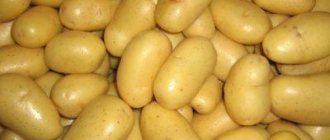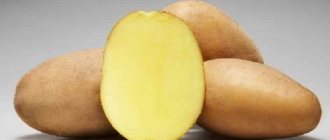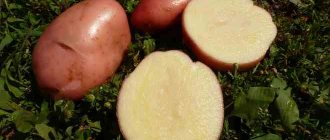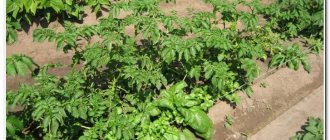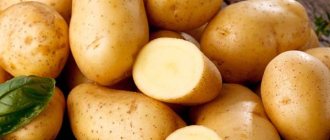Characteristics of the Favorit potato variety in the table
The table below shows the main varietal characteristics of Favorit potatoes:
| Parameter | Characteristic |
| Maturation period | 80-95 days. |
| Starch content | 12,6-16,4 % |
| Weight of marketable tubers | 101-136 |
| Number of tubers in a bush | 6-12 pcs. |
| Productivity | 170-300 c/ha, maximum 420 c/ha. |
| Consumer qualities | Ideal for making fries, it softens slightly during heat treatment. Belongs to category AB. |
| Marketability of tubers | 80-96 % |
| Keeping quality | 93 % |
| Bushes, stems, leaves | Medium-type bushes with erect shoots, medium-sized leaves, closed blade, dark green. |
| Peel color | Reddish |
| Flesh color | Cream |
| Eyes | The oblong tuber has a small number of small eyes on its surface. |
| Preferred Growing Regions | Central, Central Black Earth, Middle Volga, Lower Volga, Ural. |
| Disease resistance | The variety is absolutely resistant to cancer and nematodes, but is relatively resistant to late blight, wrinkled and striped mosaics, and leaf curl. |
| Features of cultivation | An unpretentious variety that does not require special agrotechnical conditions. |
| Year of entry into the State Register | 2014 |
Photo of the Favorite potato variety:
Description and characteristics of the variety
Favorite is a mid-season variety; these potatoes can be stored until spring with little loss (keeping quality 93%). The bushes are strong, the length of the stems is 51-62 cm. There are 6-12 large tubers in 1 nest. The shape is elongated.
The ripening time of the variety is 91-110 days after germination.
Potatoes were bred by Russian specialists from the VNIIKH named after. A.G. Lorja. It is cultivated in the middle zone, in the Central region.
What are the distinctive features of potatoes:
- average weight 101-136 g;
- starchiness 12.6-16.4%;
- skin color is red;
- surface with slight roughness;
- the pulp is creamy;
- there are few eyes, up to 3 mm in size;
- table use of AB.
The tubers received a score of 4.2-4.6 points for taste. They make a tender puree, boiled in their skins and side dishes in slices. Potatoes do not darken or disintegrate when fried.
Immune protection data:
| Resistance indicators | Diseases |
| Strong | Cancer Globoderosis Mosaic Curling leaves |
| Moderate | Rhizoctoniosis Scab Phytophthora of tuber crops |
| Weak | Late blight of the green part |
Detailed description of the Favorit potato variety
The Favorit potato does not differ in appearance from its hybrid counterparts.
Bushes
Mid-ripening potatoes have low shoots up to 60 cm long, the bush is compact, the leaf blades are medium-sized and dark green. The final ripening of the crop occurs 80-95 days after emergence.
Tubers
On one bush, from 6 to 12 tubers weighing up to 135 g are formed, oblong in shape with a reddish peel and creamy pulp. There are few eyes on the surface, they are small and shallow. Therefore, large tubers cut into pieces are not recommended for planting. Potatoes contain up to 17% starch, have average boilability during heat treatment, do not darken for a long time after peeling and are suitable for making fries.
In addition, it complements salads, soups and is used in the production of chips. The dug up tubers are distinguished by high marketability and good keeping quality, thanks to which the crop can be stored for a long time without loss of taste.
Productivity, ripening time
Favorite belongs to mid-season potato varieties. From each bush it is possible to collect up to 12 tubers weighing up to 135 g. The yield of plantings ranges from 170 to 300 c/ha. The maximum yield was 420 c/ha.
Potatoes can be dug up 95 days after planting in the ground.
Resistance of the potato variety Favorit to diseases and pests (table)
| Name of the disease | Degree of stability |
| Cancer | High |
| Globoderosis | High |
| Curling leaves | High |
| Mosaic | High |
| Late blight of tubers | Average |
| Scab | Average |
| Rhizoctoniosis | Average |
| Late blight of tops | Low |
For which regions is the Favorite potato variety suitable?
The Favorite variety was bred for cultivation in the Central regions of the country. It is there that it shows its best varietal qualities, withstands diseases and produces a rich harvest.
The best potato varieties and their descriptions
All potato varieties known to the world can be divided into four large groups depending on the timing of their full ripening.
Ultra-early potato varieties that produce a harvest already 70-80 days after planting (Agata, Karatop, Aksamit, Vineta, Rozara, Uladar, Yakutyanka, Jewel, etc.). Early potato varieties are in great demand on the market due to the unique taste of their tender young pulp. This type is the most profitable and profitable. It is always sold at a relatively high price.
Mid-early varieties, ripening in 80-90 days (Ramos, Innovator, Safo, Lileya, Svitanok, Breeze, Rozhdestvensky, etc.).
Mid-season varieties with a ripening period of 90-110 days (Diamant, Bouquet, Dar, Zhigulevsky, Garnet, etc.).
Late potato varieties that require 110-140 days for full ripening (Cardinal, Lorch, Zolsky, Veteran, etc.). Along with mid-season varieties, they are excellent for long-term storage.
The type of potatoes for planting is determined individually, and depends on the plans and tasks set by the farmer.
The best varieties suitable for growing here
Let's look at the most popular table potato varieties, which are perfectly suited for cultivation in our climatic conditions and are guaranteed to produce excellent yields with relatively little care.
Let's consider the varieties Karatop and Uladar, Breeze and Vineta, Lileya and Lorch. The description of these popular varieties, as well as their detailed characteristics, is as follows:
Innovator is a mid-early table variety that is ideal for deep-frying. From one hectare you can get more than 100 centners of Innovator potatoes. Provided a sufficient amount of fertilizer is applied, this figure can exceed 200 c. The Innovator tuber has an elongated oval shape with many small eyes on the surface. The skin of the Innovator potato variety is yellow and rough, and the flesh is often light yellow. When growing Innovator, it is worth considering that this variety is susceptible to diseases of the golden cyst nematode, as well as late blight, therefore, for the purpose of prevention, it would not hurt to treat the field in a timely manner with highly effective chemicals.
Uladar. The taste of this early ripening potato is the most excellent indicator. Moreover, it produces a good harvest on virtually any type of soil, which makes it possible to cultivate this variety in any region of Ukraine, Russia and Belarus. The average weight of the Uladar potato ranges from 90 to 140 grams, and the record weight of the tuber has reached 180 g. The yield of Uladar is 50 tons per hectare, but this figure (if sufficient fertilizer is used) can increase to 70 tons. And this despite the fact that Uladar tolerates medium-term drought well, which does not particularly affect the size of the harvest. Uladar potatoes are deservedly considered one of the best Belarusian breeding varieties! Uladar practically does not lose its presentation and is not afraid of mechanical damage. It is also worth noting that the Uladar variety is perfectly stored. The official history of the early Cherry variety dates back to 2000, when it was included in the state register. Cherry tubers have a pink-red color, they are rough to the touch, but they taste sweet. Up to ten potatoes ripen on one bush, the weight of each can exceed 500 g.
Uladar
Karatop is an early-ripening table potato variety. Research has shown that Karatop produces excellent yields even without the use of fertilizers! It has an oval tuber with a yellow skin, light flesh and relatively little starch. Consumers love Karatop potatoes for their pleasant taste, as well as their beautiful, regular shape. The average weight of a Karatop tuber ranges from 55 to 110 grams, depending on weather conditions during the growth period and the regularity of watering. Although Karatope is susceptible to various potato diseases (in particular late blight), it is also amenable to preventive treatment. But Karatop is absolutely resistant to the virus that causes leaf curl. Choosing this variety will be a good solution for planting in areas with a moderately hot climate.
Article on the topic: Potato variety “Gourmet” - description and photo
Karatop
Vineta is a very attractive and appetizing variety! The first digging of Vineta can be done already on the 45th day after the tubers have fully germinated. The maximum yield of Vineta was recorded at 238 c/ha. TubersVinetas are usually medium in size, have a pleasant taste, and tolerate transportation and storage in the cellar well. As for susceptibility to diseases, Vineta is a variety that is susceptible to the harmful effects of late blight, but it is not afraid of cancer and nematodes. Vineta potatoes tolerate drought well, so it is advisable to plant them in warm regions with insufficient average monthly precipitation. By the way, Vineta is highly marketable, which makes the variety very in demand on the market.
Vineta
Briz , developed by the Belarusian Research Institute of Potato Growing, is a mid-early potato variety, and is famous for its rapid accumulation of yield. When cooked, Breeze practically does not boil over, maintaining its excellent taste. Breeze's tubers are often quite large. They have a yellow skin with a barely noticeable mesh structure. They are not afraid of any damage. The starch content is between 12 and 15 percent. Clean Breeze potatoes can often be found in packaged form in supermarkets, because they tolerate washing well and are not exposed to moisture during storage. Breeze potatoes are moderately resistant to late blight and common scab, so at the initial stage of growth it would not hurt to treat the tops with chemicals in order to preserve maximum yield. During the flowering period, small purple-red buds bloom on the Briza bush, which quickly fall off after pollination. Spraying potato tops of the Breeze variety must be done before the flowers appear. The more organic additives and other fertilizers are added to the soil, the larger the Breeze crop, which responds well to a variety of fertilizing, you will reap!
Breeze
Lilea , i.e. Lileya Belorusskaya (this is the full name of this variety) is a mid-early round-oval potato. The tops reach medium height. It bears small, slightly wavy leaves, and during flowering a white corolla grows. The maximum yield of Liley can exceed 400 c/ha. Liley's peel is yellow, with small eyes located on it, the flesh is often light, but with a slight yellowish tint. Liley's taste, although not very expressive, is still quite pleasant. According to generally accepted standards, the shelf life of Liley potatoes is 90 percent, and the starch content balances at 10-15%. This variety is valued for the fact that it is practically not susceptible to the main diseases characteristic of this crop.
The mid-late variety Lorch is named after the outstanding Soviet breeder, Doctor of Agricultural Sciences Alexander Georgievich Lorch, who stood at the origins of domestic potato variety testing and breeding. In the state register, the description of Lorch potatoes was recorded back in 1931. Since then, the variety has undergone virtually no changes. It has light beige colored tubers with a high starch content. That is why the Lorch variety is equally successfully used both for food and for the production of starch. By the way, the taste of Lorch potatoes is pleasant and memorable: once you try it, you won’t confuse it with any other variety! The keeping quality of this species is considered to be increased, which makes it possible to store Lorch tubers for the whole winter without losing their commercial qualities. Farmers prefer to use Lorch in planting also because it is not susceptible to infection by viruses, late blight, bacteriosis and dry rot. Lorch is also quite unpretentious in cultivation and care. All around, Lorch is an excellent variety!
Medium late variety Lorch
Agata variety , although originally from the Netherlands, has taken root in our area a long time ago, and is popular along with domestic types of potatoes. When starting to grow Agata, one should not forget about the need to carry out high-quality seed treatment before planting, as well as spraying the bushes during the intensive growing season. High yields of Agata potatoes are often formed after the 50th day from planting. It is recommended to dig up Agatha tubers in early or mid-August.
Related article: Potato varieties for the North-West region: list
Agatha
Jewel is a very early potato. You can dig the first tubers 55 days after planting! If you don’t dig up Jewel right away, but wait for it to fully grow, you can achieve quite a high yield of 65 t/ha. The advantages of Jewel potatoes, naturally, are their early ripening, which allows the harvested crop to be sold at a fairly high price. By ensuring regular watering, you will get large-sized Jewel tubers with a pleasant, pronounced taste. The only negative is that Jewel variety potatoes often suffer from late blight and scab, so during the growing process, carefully ensure that your crop is not subject to the harmful effects of these and other diseases. But by taking care of the reliable protection of the Jewel variety, you will receive large, beautiful tubers of the correct shape, which are in constant demand among consumers!
Jewel
The Manifest variety was bred by Belarusian breeders. On the territory of the Russian Federation it is grown in the central and northwestern regions. It has excellent taste and quick cooking properties. Manifest is very resistant to viruses and is not afraid of late blight, blackleg and scab. It is not susceptible to mechanical damage. Manifest potatoes are recommended to be grown intensively on soils of light to medium texture. As for planting recommendations, it is important to take into account that on one hectare the average number of Manifesto potato bushes should not exceed 50 thousand pieces.
Manifesto
The mid-season Favorite variety was obtained by crossing Romano and Udacha potatoes. The result of the selection was delicious potatoes with creamy pulp and pink skin, which appealed to many! It tolerates transportation well and is stored for a long time.
Gala potatoes are an early variety. It was bred by German breeders. Characterized by large leaves, tall tops and weak flowering. Gala potatoes are excellent for marketing because the availability of marketable tubers after harvest is often high at 95 percent. Gala has an excellent, pronounced taste, which allows this variety to stand out noticeably from the general background. Stable resistance to viruses and other diseases is another advantage of Gala.
Potato Gala
Crane . A mid-late table variety, native to the Republic of Belarus. Growing this type of potato allows you to get a yield of up to 75 tons per hectare of land. At the same time, the starch content in tubers is quite high. The figure reaches 19 percent. The Zhuravinka tubers themselves are distinguished by a rich dark red hue, round or round-oval shape and yellowish flesh. Potatoes have a pleasant taste, which makes them one of the most favorite among consumers. Crane is good for making chips, which is why this variety is in high demand among companies producing these crunchy snacks. The multi-tuberous potato Zhuravinka is also popular due to its high resistance to various diseases (potato cancer, nematodes, viruses, bacteria, scab).
Zhuravinka
As we were able to clearly see, the best potato varieties are those that are resistant to various diseases and droughts, have excellent taste and are characterized by high yields. After reading the detailed description, you can now choose the variety that is sure to suit your taste!
Advantages and disadvantages of the Favorit potato variety
The Favorite variety has a number of advantages and disadvantages. They are presented in the table below.
| Advantages | Flaws |
|
|
Features of growing the Favorit potato variety
The Favorite variety does not require specific agrotechnical growing conditions; the care features do not differ from the care of other potato varieties. Due to the small number of eyes on large tubers, they are not recommended for planting in cut form; all planting material must be pre-processed and germinated.
Requirements for the landing site and its preparation
The land for planting potatoes has been prepared since the fall, supplemented with fertilizers and green manure planted. Well-lit areas of the site are suitable for potatoes.
During planting, add a handful of mullein or any other nutritious organic matter to the hole if the soil is poor enough.
During the period of growth of the vegetative mass, you can feed the plantings with nitrogenous fertilizers, and during the flowering period, add phosphorus and potassium supplements. Spraying is carried out with magnesium or boron preparations.
When choosing a place for planting, you must take into account the rules of crop rotation and try not to plant potatoes in the ground after unsuitable predecessors, for example, after tomatoes.
Selection and preparation of seed tubers
For planting, you need to choose healthy medium-sized tubers without signs of damage. They must be germinated before being placed in the garden bed and treated with Acrobat, Fitosporin or Kuproxat. They will help strengthen the immune system and activate potato growth.
Landing dates and rules
It is recommended to start planting potatoes only when the ground warms up to +11 °C. The temperature can be measured with an outdoor thermometer, buried at the depth of planting potatoes for several hours.
In the central zone of Russia, work begins in early May or at the end of April, if, according to weather forecasters, night frosts are not expected.
The planting depth depends on the type of soil and varies from 8 to 12 cm. The optimal distance between tubers is 30 cm, and between rows - 70 cm.
Potatoes: an international favorite
Wild potatoes were “domesticated” by the Incas Indians approximately 14 thousand years ago, but they came to Europe thanks to the Spanish conquistador Pedro Cieza de Leon in 1551. However, it took Europeans about a hundred years to recognize potatoes as suitable for food, since potatoes were similar to plants of the Solanaceae family, and their poison - solanine - was often used to get rid of unwanted ones. Well, in general, the Europeans were right. Wild potatoes are a poisonous plant, all of its parts - leaves, flowers, stems, roots and even the tubers themselves - are naturally poisonous. And only the brilliant Incas managed to grow potatoes without poison. However, there is one “but”.
Do you know why it is better to throw away green potatoes? Potato tubers tend to turn green when stored in light, which indicates an increased solanine content. If you eat such potatoes, you risk serious poisoning.
Why did you even have to go through the trouble of growing and preparing this potentially poisonous product?
Article on the topic: Potato variety “Argos” - description and photo
During his expedition to Patagonia, British naturalist Charles Darwin wrote the following in his diary: “It is remarkable that the same plant can grow in the sterile mountains of Central Chile, where there is no rain for six months, and in the damp forests of the southern islands.” . The plant that Darwin described was the potato. The potato tuber is unique both in its adaptability and nutritional value. In addition to the necessary starch, potatoes contain a lot of vitamin C, B1, B6, B2, K, vitamin E, potassium and phosphorus, folic and nicotinic acid, malic, citric and oxalic organic acids, iron, sodium, magnesium, calcium, iodine, manganese, copper, zinc, nickel, cobalt, boron and fiber.
In fact, potatoes are a source of almost all the vitamins and substances the body needs, with the exception of calcium, vitamin A and vitamin D.
So, we have a very useful and nutritious plant that can produce a large harvest in a small area and in almost any climate zone. Once the Europeans realized all this, potatoes quickly entered and took pride of place in the kitchens of all European countries.
This was a short historical excursion, and we will return to the kitchen.
1. High starchy – crumbly, therefore best suited for mashing, boiling potatoes in their skins or baking in the oven. Usually these are mid-season and mid-late varieties, yellow tubers. Our most common one is “Sineglazka”.
2. Medium starch content - best for frying. It is ideal for gratin and potato pancakes.
3. Low starch content - does not boil soft, so it is usually used for making salads and soups. Usually these are early and mid-early varieties, pink tubers.
Today we will focus on the first group and prepare regular baked potatoes.
Potato varieties of Russian selection
Caring for the Favorite potato variety
To obtain a rich harvest, the Favorite variety needs watering, fertilizing, hilling, loosening and weeding.
Watering
Watering of Favorite potatoes can be carried out only 10 days after emergence. Then the soil is moistened 2-3 more times per season, it all depends on weather conditions.
The last time the plantings should be watered is 3-4 weeks before digging.
Water consumption is 20-40 liters per 1 square. m.
Top dressing
Most of the fertilizers for potatoes are added in the fall, and in the spring the soil is dug up and becomes suitable for planting.
If the soil is not nutritious enough and has been used for several years without a break, then the tubers may grow poorly and have insignificant mass. In this case, it is necessary to additionally feed the plantings, combining this procedure with hilling.
For root watering, a solution is diluted according to one of the recipes below, which is poured in an amount of 500 ml under each bush:
- Nitrogen is mixed with potassium and phosphorus in a ratio of 2:1:1 so that the total mass does not exceed 25 g. The mixture is dissolved in 10 liters of water.
- Dissolve 3 tbsp in 10 liters of water. l. wood ash and 1 tbsp. l. potassium sulfate.
To increase the nutritional value of the beds, the row spacing can be watered with diluted manure at a rate of 1:10.
Loosening, weeding, hilling
A week after the first shoots appear, you need to carefully loosen and weed the beds, removing weeds even between the rows.
Next is hilling. This is done twice a season:
- The first time the earth is raked towards the shoots is when their height reaches 20 cm.
- It is recommended to hill up the potatoes a second time during the flowering period, and the height of the embankment increases by about 5 cm.
Hilling helps prevent the formation of a dense crust on the surface of the bed, which prevents the penetration of moisture and air. In addition, the eggs of the Colorado potato beetle and other pests are destroyed.
Protection of the Favorit potato variety from diseases and pests (table)
As we noted above, the Favorit variety exhibits high resistance to cancer, leaf curl and mosaic. But under unfavorable weather conditions, overwatering, drought or violations of crop rotation rules, he may develop late blight of the above-ground part of the bush.
| Name of the disease | Manifestation | Treatment and prevention |
| Late blight of tops | In case of unfavorable weather and violation of the rules of care, dark brown spots appear on the shoots, after which the leaves wither. The shoots look sick and burned. | To prevent diseases, tubers must be treated before planting and germinated to strengthen the immune system. When signs of fungus appear, the plantings are treated with specialized products Gamair, Bravo, Oxyx or Metaxil until the symptoms disappear completely. |
| Colorado beetle | Orange clutches of larvae appear on the back of the leaves; the leaves are eaten by the adults. | If the number of pests is small, they can be collected manually and destroyed; leaves with larvae should be torn off. If there are too many individuals, then treatment with specialized products Komandor, Aktellik, Corado, Prestige, Aktara will help. |
| Wireworm | A long and dense worm that leaves behind numerous labyrinthine passages in the tubers. | For prevention, experienced gardeners recommend adding a handful of onion peels to the hole. The drugs Aktara, Bazudin, Prestige, Grom, Zemlin will help overcome the pest. |
Photo gallery of drugs for controlling diseases and pests of the Favorit potato variety:
From late blight From late blight
From late blight
From late blight, alternaria
From the Colorado potato beetle From the Colorado potato beetle, scale insect From the Colorado potato beetle From the Colorado potato beetle, wireworm and a number of fungal diseases
From the Colorado potato beetle
From the wireworm
From wireworm, mole cricket
From the wireworm
Nevsky
Brought out in 1976 after crossing Candidate and Veselovskaya, it belongs to the mid-season varieties. Both “parents” gave the variety the best qualities:
high yield - up to 2 kg of smooth, oblong tubers per bush;
good ripening time - up to 75 days;
responsiveness to organic matter and mineral fertilizers;
the ability to recover from an attack by the Colorado potato beetle.
During prolonged drought, the variety rolls its leaves into tubes to lose as little moisture as possible.
Nevsky does not tolerate cold weather, so harvesting should be done before the first frost.
To get a good harvest, it is better to expose the seed material to light in a warm room. This will harden the tubers and help them gain a sufficient amount of solanine, a substance poisonous to earthen pests.
The nuances of collecting and storing the Favorite potato variety
Tubers ripen 80-95 days after emergence. A sign of maturity is the withering of the tops, but many gardeners cut off the tops a week before starting work.
The harvested potatoes are carefully sorted, putting tubers separately for food, seeds and damaged tubers.
Seed potatoes are left in the sun for gardening, and the tubers intended for storage are ventilated and dried in a shaded place for 2-3 hours, then put in boxes or bags and sent to a well-ventilated, cool place with a temperature no higher than +4 °C.
Thanks to its good keeping quality in such conditions, the Favorite crop will quietly last until the next season.
Comparison of the Favorit potato variety with other varieties in the table
| Variety | Ripening time (number of days before ripening) | Starch (%) | Productivity (c/ha) | Tuber weight (g) Number of tubers per bush | Keeping quality (%) |
| Favorite | Mid-season*** | 12,6-16,4 | 420 | 101-136 6-12 | 93 |
| Luck | Early ripening* | 11-15 | 420-430 | 100-150 10-15 | 88-97 |
| Adretta | Mid-season*** | 15-18 | 450 | 100-150 10-25 | 95 |
| Miner | Mid-early** | 14-19 | 600 | 90-140 12-18 | 97 |
| Gulliver | Early ripening* | 14-20 | 650-700 | 100-150 5-11 | 95 |
| Irbitsky | Mid-early** | 12-17 | 250-400 | 100-185 6-8 | 97 |
| Kumach | Mid-season*** | 12-18 | 241-719 | 98-260 12-25 | 98 |
| Lapot | Mid-early** | 12-14 | 450-500 | 100-160 6-10 | 94 |
| Lyubava | Early ripening* | 11-17 | 288-400 | 110-210 up to 20 | 98 |
| Rodrigo | Mid-early** | 12,5-15,4 | 450 | 700-800 7-9 | 95 |
*Early ripening – 50-65 days.
**Mid early – 65-80 days.
***Mid-ripening – 80-95 days.
